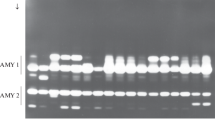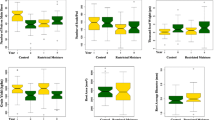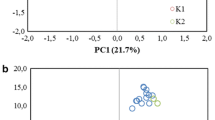Summary
The quantitative traits height and ear-emergence date were analyzed in the F2 progeny of a cross between a tall winter barley cultivar (Gerbel) and a short spring barley cultivar (Heriot). The trait distributions were found to be related to the genotypes at two biochemical loci, β-amylase (Bmy1) and water-soluble protein (Wsp3), which are known to lie on the long arm of chromosome 4. Linkages between each trait and the markers were investigated using normal mixture models. The two parental phenotypes and the heterozygote phenotype of Bmy1 were distinguishable so the model could be used directly to estimate linkage between Bmy1 and a quantitative trait locus (QTL) for height (Height). The Gerbel homozygote and heterozygote phenotype of Wsp3 could not be distinguished and the model was adapted accordingly. The proportion of plants requiring vernalization was consistent with control by two independent genes acting epistatically, and a normal mixture model based on a two-gene hypothesis was fitted to the distribution of ear-emergence date to estimate linkage between the marker loci and a QTL for ear-emergence date (Vrn1). The parameters of each model were the recombination fraction between the marker locus and the QTL and the means and standard deviations associated with each QTL genotype; these were estimated by maximum likelihood. The fitted distributions correspond well to those observed and the order of the loci along the chromosome is inferred to be Height — Vrn1 — Bmy1 — Wsp3, with Wsp3 being the most distal.
Similar content being viewed by others
References
Ainsworth CC, Gale MD, Baird S (1983) The genetics of β-amylase isozymes in wheat. 1. Allelic variation among hexaploid varieties and intrachromosomal gene locations. Theor Appl Genet 66:39–49.
Chojecki J, Barnes S, Dunlop A (1989) A molecular marker for vernalisation requirement in barley. In: Helentjaris T, Burr B (eds) Development and application of molecular markers to problems in plant genetics. Current Commun Mol Biol. Cold Spring Harbour Laboratory, Cold Spring Harbour, New York, pp 145–148.
Doll H, Haahr V, Søgaard B (1989) Relationship between vernalization requirement and winter hardiness in doubled haploids of barley. Euphytica 42:209–214.
Ellis RP, Russell G (1984) Plant development and grain yield in spring and winter barley. J agric Sci Camb 102:85–95.
Forster BP, Ellis RP (1991) Two biochemical markers for spring/winter habit. In: Munck L, Kirkegaard K, Jensen B (eds) Barley genetics VI. Proc 6th Int Barley Genet Symp, Helsingborg, Sweden 1991 Munksgaard International Publishers Ltd, Copenhagen, pp 101–103.
Forster BP, Thompson DM, Watters J, Powell W (1991) Watersoluble proteins of mature barley endosperm: genetic control, polymorphism and linkage with β-amylase and spring/winter habit. Theor Appl Genet 81:787–792.
Jensen J (1989) Estimation of recombination parameters between a quantitative trait locus (QTL) and two marker gene loci. Theor Appl Genet 78:613–618.
Kirby EJM, Ellis RP (1980) A comparison of spring barley grown in England and in Scotland. J agric Sci Camb 95:101–110.
Kjaer B, Haahr V, Jensen J (1991) Associations between 23 quantitative traits and 10 genetic markers in a barley cross. Plant Breed 106:261–274.
Knapp SJ, Bridges WC Jr, Birkes D (1990) Mapping quantitative trait loci using molecular marker linkage maps. Theor Appl Genet 79:583–592.
Lander ES, Botstein D (1989) Mapping Mendelian factors underlying quantitative traits using RFLP linkage maps. Genetics 121:185–199.
Law CN, Worland AJ, Giorgi B (1976) The genetic control of ear-emergence time by chromosomes 5A and 5D of wheat. Heredity 36:49–58.
Liu CJ, Gale MD (1989) Ibf-1 (Iodine-binding factor), a highly variable marker system in the Triticeae. Theor Appl Genet 77:233–240.
Luo ZW, Kearsey MJ (1989) Maximum likelihood estimation of linkage between a marker gene and a quantitative locus. Heredity 63:401–408.
Luo ZW, Kearsey MJ (1991) Maximum likelihood estimation of linkage between a marker gene and a quantitative trait locus. II. Application to backcross and doubled haploid populations. Heredity 66:117–124.
Nelder JA, Mead R (1965) A simplex method for function minimisation. Computer J 7:308–313.
Nielsen G, Johansen H, Jensen J (1983) Localization on barley chromosome 4 of genes coding for β-amylase (Bmy1) and protein Z (Paz1). Barley Genet Newslett 13:55–57.
Pugsley AT (1972) Additional genes inhibiting winter habit in wheat. Euphytica 21:547–552.
Søgaard B, Wettstein-Knowles P von (1987) Barley: genes and chromosomes. Carlsberg Res Commun 52:123–196.
Takahashi R, Hayashi J (1966) Inheritance and linkage studies in barley. II. Assignment of several new mutants to their respective linkage groups by trisomic method analysis. Ber Ohara Inst Land-wirtsch Biol, Okayama University 13:185–198.
Takahashi R, Hayashi J, Yasuda S (1957) Four genes in linkage, which are inherited independently of the markers in the known linkage groups in barley. Nogaku Kenkyu 45:1–10.
Takahashi R, Yasuda S (1970) Genetics of earliness and growth habit in barley. In: Nilan RA (ed) Barley genetics II. Proc 2nd Int Barley Genet Symp, Washington 1970. Washington State University Press, pp 388–408.
Thomas WTB, Powell W, Swanston JS (1990) Association of two dwarfing genes with quality, yield and agronomic characters in spring barley. Aspects Appl Biol 25:131–141.
Thomas WTB, Powell W, Forster BP, Swanston JS (1992) The effects of three linked major genes (ml-o, Bmy1 and Wsp3) on quantitatively varying characters in barley. Ann Appl Biol (in press).
Thompson DM, Powell W, Forster BP (1990) Use of isoeletricfocusing in barley varietal identification. Ann Appl Biol 117:625–631.
Weller JI (1986) Maximum likelihood techniques for the mapping and analysis of quantitative trait loci with the aid of genetic markers. Biometrics 42:627–640.
Weller JI (1987) Mapping and analysis of quantitative trait loci in Lycopersicon (tomato) with the aid of genetic markers using approximate maximum likelihood methods. Heredity 59:413–421.
Yasuda S (1981) The physiology of earliness in barley. In: Asher MJC, Ellis RP, Hayter AM, Whitehouse RNH (eds) Barley genetics IV. Proc 4th Int Barley Genet Symp, Edinburgh. Edinburgh University Press, pp 507–517.
Author information
Authors and Affiliations
Additional information
Communicated by J. W. Snape
Rights and permissions
About this article
Cite this article
Hackett, C.A., Ellis, R.P., Forster, B.P. et al. Statistical analysis of a linkage experiment in barley involving quantitative trait loci for height and ear-emergence time and two genetic markers on chromosome 4. Theoret. Appl. Genetics 85, 120–126 (1992). https://doi.org/10.1007/BF00223854
Received:
Accepted:
Issue Date:
DOI: https://doi.org/10.1007/BF00223854




